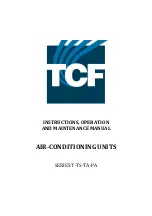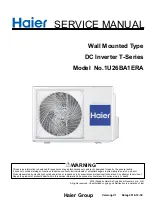
SERVICING
40 Rev 1
The pressure cutouts will be installed outside the unit
casing. They are weatherproof but not tamperproof. Tam-
pering with the pressure cutouts could cause a refrigerant
leak and possible equipment damage. If possible, discuss
this with the building owner before installing these controls.
T2 T1
L2 L1
BLACK 1
THERMOSTAT
WIRE
LOW PRESSURE
CUTOUT
HIGH PRESSURE
CUTOUT
SHORT CYCLE
PROTECTOR
WIRE NUT
YELLOW 1
BLACK 1
Y1
Y2
R1
R2
Y
C
UNIT
TERMINAL
BOARD
CONTACTOR
PCK02A Remote Heat Pumps
ASC kits contain a short-cycle protector for use on units with
reciprocating compressors ( most units with scroll compres-
sors have anti-short cycle protectors installed at the factory).
ASC01A Anti Short Cycle Protector
S-66 FFK02A & FFK03A, FOSSIL FUEL KITS
(OPTIONAL ITEM)
The fossil fuel kit controls are designed for use with Amana
remote Heat Pumps in conjunction with oil, electric or gas
furnaces. FFK02A's are for use with RHA/RHDA2B models.
FFK03A are for use with all RHA, RHD, RHE, & RHF
models. The controls in the kit, when correctly installed and
electrically connected, should operate to minimize the an-
nual heating cost by operating the most economical heating
system (heat pump or the fossil fuel furnace). The FFK02A
kit cannot be used on RHA--B2A units, the FFK03A kit must
be used.
The kit consists of a control board and outdoor thermostat.
The function of the outdoor thermostat is to permit on the job
site setting of the economic break-even outdoor tempera-
ture based on current fossil fuel and electric rates. For the
system to operate properly, a two-stage heating and one-
stage cooling thermostat is required (not part of this kit) for
single stage furnaces. A three-stage heating and one-stage
cooling room thermostat is also required (not a part of this
kit) for two-stage furnaces
S-100 REFRIGERATION REPAIR PRACTICE
DANGER
ALWAYS REMOVE THE REFRIGERANT CHARGE IN A
PROPER MANNER BEFORE APPLYING HEAT TO THE
SYSTEM.
When repairing the refrigeration system:
WARNING
Disconnect Electrical Power Supply:
1. Never open a system that is under vacuum. Air and
moisture will be drawn in.
2. Plug or cap all openings.
3. Remove all burrs and clean the brazing surfaces of the
tubing with sand cloth or paper. Brazing materials do not
flow well on oxidized or oily surfaces.
4. Clean the inside of all new tubing to remove oils and pipe
chips.
5. When brazing, sweep the tubing with dry nitrogen to
prevent the formation of oxides on the inside surfaces.
6. Complete any repair by replacing the liquid line drier in
the system, evacuate and charge.
BRAZING MATERIALS
Copper to Copper Joints
- Sil-Fos used without flux (alloy
of 15% silver, 80% copper, and 5% phosphorous). Recom-
mended heat 1400°F.
Copper to Steel Joints
- Silver Solder used without a flux
(alloy of 30% silver, 38% copper, 32% zinc). Recommended
heat - 1200°F.
S-101 LEAK TESTING
Refrigerant leaks are best detected with a halide or elec-
tronic leak detector.
However, on outdoor installed systems, provisions must be
made to shield the copper element of an halide torch from
the sun and wind conditions in order to be able to see the
element properly.
NOTE:
The flame of the halide detector will glow green in
the presence of R-22 refrigerant.
















































